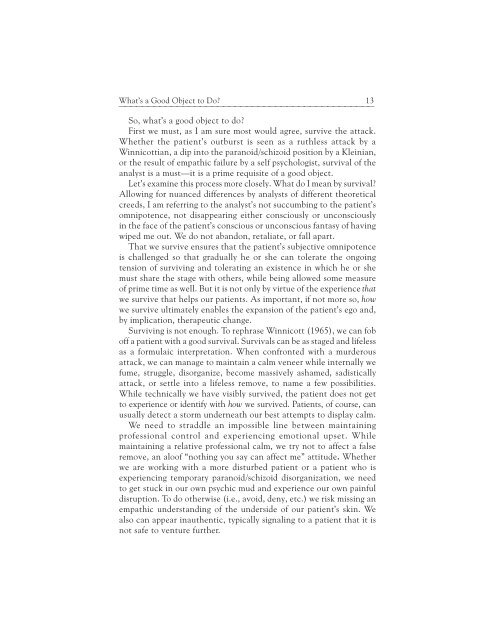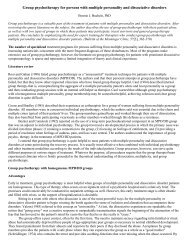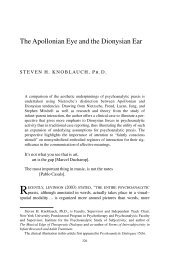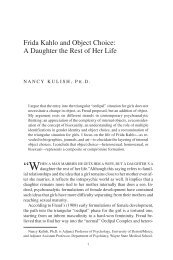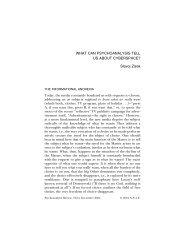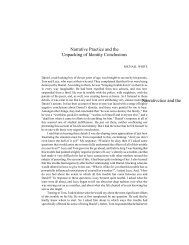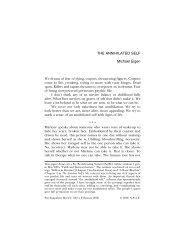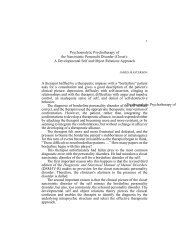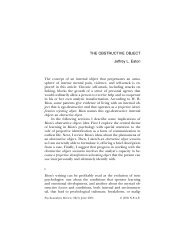What's a Good Object to Do? - PsyBC
What's a Good Object to Do? - PsyBC
What's a Good Object to Do? - PsyBC
Create successful ePaper yourself
Turn your PDF publications into a flip-book with our unique Google optimized e-Paper software.
What’s a <strong>Good</strong> <strong>Object</strong> <strong>to</strong> <strong>Do</strong> 13<br />
⎯⎯⎯⎯⎯⎯⎯⎯⎯⎯⎯⎯⎯⎯⎯⎯⎯⎯⎯⎯⎯⎯⎯⎯⎯⎯⎯⎯⎯⎯⎯⎯⎯⎯⎯⎯⎯⎯⎯⎯⎯⎯⎯⎯<br />
So, what’s a good object <strong>to</strong> do<br />
First we must, as I am sure most would agree, survive the attack.<br />
Whether the patient’s outburst is seen as a ruthless attack by a<br />
Winnicottian, a dip in<strong>to</strong> the paranoid/schizoid position by a Kleinian,<br />
or the result of empathic failure by a self psychologist, survival of the<br />
analyst is a must—it is a prime requisite of a good object.<br />
Let’s examine this process more closely. What do I mean by survival<br />
Allowing for nuanced differences by analysts of different theoretical<br />
creeds, I am referring <strong>to</strong> the analyst’s not succumbing <strong>to</strong> the patient’s<br />
omnipotence, not disappearing either consciously or unconsciously<br />
in the face of the patient’s conscious or unconscious fantasy of having<br />
wiped me out. We do not abandon, retaliate, or fall apart.<br />
That we survive ensures that the patient’s subjective omnipotence<br />
is challenged so that gradually he or she can <strong>to</strong>lerate the ongoing<br />
tension of surviving and <strong>to</strong>lerating an existence in which he or she<br />
must share the stage with others, while being allowed some measure<br />
of prime time as well. But it is not only by virtue of the experience that<br />
we survive that helps our patients. As important, if not more so, how<br />
we survive ultimately enables the expansion of the patient’s ego and,<br />
by implication, therapeutic change.<br />
Surviving is not enough. To rephrase Winnicott (1965), we can fob<br />
off a patient with a good survival. Survivals can be as staged and lifeless<br />
as a formulaic interpretation. When confronted with a murderous<br />
attack, we can manage <strong>to</strong> maintain a calm veneer while internally we<br />
fume, struggle, disorganize, become massively ashamed, sadistically<br />
attack, or settle in<strong>to</strong> a lifeless remove, <strong>to</strong> name a few possibilities.<br />
While technically we have visibly survived, the patient does not get<br />
<strong>to</strong> experience or identify with how we survived. Patients, of course, can<br />
usually detect a s<strong>to</strong>rm underneath our best attempts <strong>to</strong> display calm.<br />
We need <strong>to</strong> straddle an impossible line between maintaining<br />
professional control and experiencing emotional upset. While<br />
maintaining a relative professional calm, we try not <strong>to</strong> affect a false<br />
remove, an aloof “nothing you say can affect me” attitude. Whether<br />
we are working with a more disturbed patient or a patient who is<br />
experiencing temporary paranoid/schizoid disorganization, we need<br />
<strong>to</strong> get stuck in our own psychic mud and experience our own painful<br />
disruption. To do otherwise (i.e., avoid, deny, etc.) we risk missing an<br />
empathic understanding of the underside of our patient’s skin. We<br />
also can appear inauthentic, typically signaling <strong>to</strong> a patient that it is<br />
not safe <strong>to</strong> venture further.


